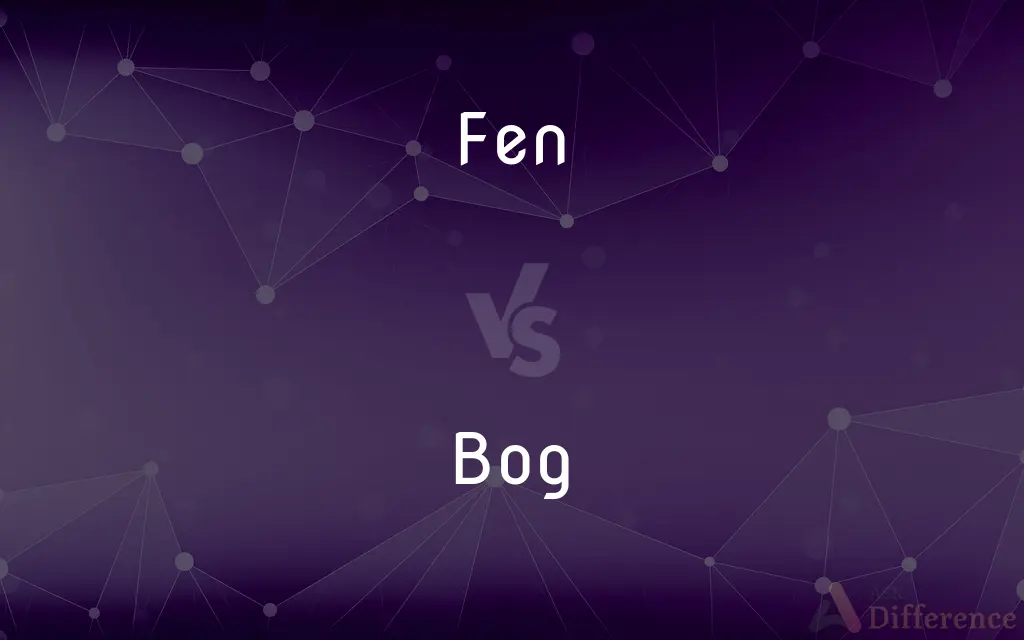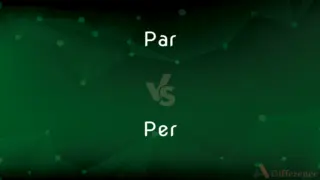Fen vs. Bog — What's the Difference?
Edited by Tayyaba Rehman — By Maham Liaqat — Updated on April 21, 2024
Fen and bog are both types of wetlands; fens are alkaline with nutrient-rich waters and diverse plant life, whereas bogs are acidic and nutrient-poor with specialized plant species.

Difference Between Fen and Bog
Table of Contents
ADVERTISEMENT
Key Differences
Fens are characterized by their alkaline, nutrient-rich waters that support a diverse range of plant species. Whereas, bogs have acidic, nutrient-poor conditions, fostering a more specialized group of plants such as sphagnum moss and carnivorous species like sundews.
Fens receive water from groundwater sources, ensuring a continuous supply of minerals and nutrients. On the other hand, bogs typically rely on rainwater, which is low in nutrients and leads to the development of peat.
The water chemistry in fens promotes a higher decomposition rate of organic material. Conversely, the acidic and cooler environment in bogs results in slower decomposition, leading to the accumulation of peat.
Plant diversity is notably higher in fens due to the more favorable growing conditions. In contrast, the harsh conditions in bogs limit plant variety to those that can tolerate low nutrient availability and high acidity.
Fens are often transitional areas between aquatic and terrestrial ecosystems and can evolve into other wetland types under changing conditions. Bogs, however, remain relatively stable over time due to their unique water and nutrient dynamics, which inhibit rapid ecological changes.
ADVERTISEMENT
Comparison Chart
PH Level
Alkaline
Acidic
Water Source
Groundwater
Rainwater
Nutrient Level
Nutrient-rich
Nutrient-poor
Decomposition
Faster decomposition
Slower decomposition
Plant Diversity
High, supports diverse plant species
Low, dominated by specialized species
Compare with Definitions
Fen
Often serves as a transition between aquatic and terrestrial ecosystems.
Birds and amphibians thrive in the transitional habitats provided by the fen.
Bog
A wetland ecosystem characterized by acidic, peat-accumulating waters.
The bog was dotted with pitcher plants and sphagnum moss.
Fen
Prone to faster organic decomposition due to its nutrient-rich environment.
In the fen, plant material decomposes quickly, enriching the soil.
Bog
Relies on rainwater and has low nutrient availability.
The bog's plant life has adapted to thrive on the minimal nutrients available.
Fen
A type of wetland fed by mineral-rich groundwater, supporting a wide range of plant species.
The fen was bustling with wildlife, indicative of its rich biodiversity.
Bog
Exhibits slower decomposition rates, leading to peat formation.
Peat in the bog builds up over centuries as plant matter decomposes slowly.
Fen
Supports a higher biodiversity compared to other wetlands.
Orchids and sedges are commonly found in the fertile environment of a fen.
Bog
Dominated by peat moss and carnivorous plants.
Carnivorous plants in the bog capture insects to supplement their nutrient intake.
Fen
Characterized by its alkaline water conditions.
The alkaline nature of the fen supports diverse aquatic plant life.
Bog
Typically found in cooler climates and remains ecologically stable.
The cool climate of the region supports the bog's unique ecosystem.
Fen
A fen is a type of peat-accumulating wetland fed by mineral-rich ground or surface water. It is one of the main types of wetlands along with marshes, swamps, and bogs.
Bog
A bog or bogland is a wetland that accumulates peat, a deposit of dead plant material—often mosses, and in a majority of cases, sphagnum moss. It is one of the four main types of wetlands.
Fen
An area of low wet land having peaty soil and typically being less acidic than a bog.
Bog
An area of wet muddy ground that is too soft to support a heavy body
A peat bog
The island is a wilderness of bog and loch
A bog of legal complications
Fen
A type of wetland fed by ground water and runoff, containing peat below the waterline, characteristically alkaline.
Bog
The toilet.
Fen
Low land overflowed, or covered wholly or partially with water, but producing sedge, coarse grasses, or other aquatic plants; boggy land; moor; marsh.
'Mid reedy fens wide spread.
Bog
Be or become stuck in mud or wet ground
The family Rover became bogged down on the beach road
Fen
100 fen equal 1 yuan
Bog
Go away
I told him to bog off
Fen
Low-lying wet land with grassy vegetation; usually is a transition zone between land and water;
Thousands of acres of marshland
The fens of eastern England
Bog
Start a task enthusiastically
If he saw a trucker in difficulty, he would just bog in and give a hand
Bog
An area having a wet, spongy, acidic substrate composed chiefly of sphagnum moss and peat in which characteristic shrubs and herbs and sometimes trees usually grow.
Bog
Any of certain other wetland areas, such as a fen, having a peat substrate. Also called peat bog.
Bog
An area of soft, naturally waterlogged ground.
Bog
Chiefly British Slang A restroom or toilet.
Bog
To cause to sink in a bog
The bus got bogged down in the muddy road.
Bog
To hinder or slow
The project got bogged down in haggling about procedures.
Bog
To be hindered and slowed.
Bog
An area of decayed vegetation (particularly sphagnum moss) which forms a wet spongy ground too soft for walking; a marsh or swamp.
Bog
(figuratively) Confusion, difficulty, or any other thing or place that impedes progress in the manner of such areas.
Bog
(uncountable) The acidic soil of such areas, principally composed of peat; marshland, swampland.
Bog
A place to defecate: originally specifically a latrine or outhouse but now used for any toilet.
Bog
An act or instance of defecation.
Bog
A little elevated spot or clump of earth, roots, and grass, in a marsh or swamp.
Bog
(obsolete) nodot=1: a bugbear, monster, or terror.
Bog
(obsolete) Puffery, boastfulness.
Bog
To sink or submerge someone or something into bogland.
Bog
(figuratively) To prevent or slow someone or something from making progress.
Bog
To sink and stick in bogland.
Bog
(figuratively) To be prevented or impeded from making progress, to become stuck.
Bog
To defecate, to void one's bowels.
Bog
To cover or spray with excrement.
Bog
To make a mess of something.
Bog
To provoke, to bug.
Bog
To go away.
Bog
(obsolete) Bold; boastful; proud.
Bog
A quagmire filled with decayed moss and other vegetable matter; wet spongy ground where a heavy body is apt to sink; a marsh; a morass.
Appalled with thoughts of bog, or caverned pit,Of treacherous earth, subsiding where they tread.
Bog
A little elevated spot or clump of earth, roots, and grass, in a marsh or swamp.
Bog
To sink, as into a bog; to submerge in a bog; to cause to sink and stick, as in mud and mire.
At another time, he was bogged up to the middle in the slough of Lochend.
Bog
Wet spongy ground of decomposing vegetation; has poorer drainage than a swamp; soil is unfit for cultivation but can be cut and dried and used for fuel
Bog
Cause to slow down or get stuck;
The vote would bog down the house
Bog
Get stuck while doing something;
She bogged down many times while she wrote her dissertation
Common Curiosities
What type of plants are common in bogs?
Sphagnum moss and carnivorous plants like pitcher plants are common in bogs.
Why are bogs acidic?
Bogs are acidic primarily because they are isolated from groundwater and rely on rainwater, which lacks nutrients.
Can fens evolve into other wetland types?
Yes, fens can transition into other types of wetlands as environmental conditions change.
How do fens receive their water?
Fens are mainly fed by groundwater, which is rich in minerals.
Can animal species differ between fens and bogs?
Yes, the different plant communities and water chemistries in fens and bogs support varied animal species.
What environmental conditions favor the formation of a bog?
Cooler climates and high acidity, combined with poor nutrient availability, favor bog formation.
Is there a geographical preference for the location of fens and bogs?
Fens are often found in areas with abundant groundwater, while bogs are more common in cooler, rainier regions.
What is the main difference between a fen and a bog?
Fen is alkaline and nutrient-rich, supporting diverse flora; a bog is acidic and nutrient-poor with specialized plants.
Why do bogs have slower decomposition rates?
The cooler, acidic conditions in bogs inhibit the rapid breakdown of organic materials.
What impact does groundwater have on the biodiversity of a fen?
Groundwater brings minerals and nutrients that significantly enhance the biodiversity of a fen.
Are fens richer in biodiversity than bogs?
Yes, the nutrient-rich conditions in fens support a higher diversity of plants and animals compared to bogs.
How does the water chemistry affect plant life in fens and bogs?
Alkaline, nutrient-rich water in fens supports diverse plant life, while acidic, nutrient-poor water in bogs supports specialized species.
What is peat, and why is it commonly associated with bogs?
Peat is partially decomposed organic matter that accumulates in bogs due to slow decomposition rates.
What role do fens and bogs play in the ecosystem?
Both fens and bogs are crucial for biodiversity, water filtration, and carbon storage, each contributing uniquely based on their ecological characteristics.
How do carnivorous plants in bogs obtain nutrients?
Carnivorous plants in bogs supplement their nutrient intake by capturing and digesting insects.
Share Your Discovery

Previous Comparison
Scrutinize vs. Analyze
Next Comparison
Par vs. PerAuthor Spotlight
Written by
Maham LiaqatEdited by
Tayyaba RehmanTayyaba Rehman is a distinguished writer, currently serving as a primary contributor to askdifference.com. As a researcher in semantics and etymology, Tayyaba's passion for the complexity of languages and their distinctions has found a perfect home on the platform. Tayyaba delves into the intricacies of language, distinguishing between commonly confused words and phrases, thereby providing clarity for readers worldwide.
















































